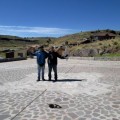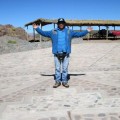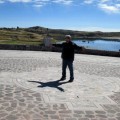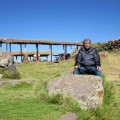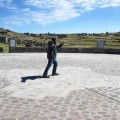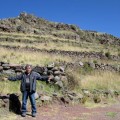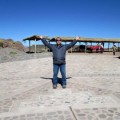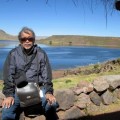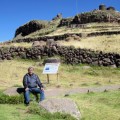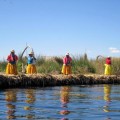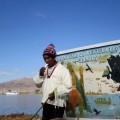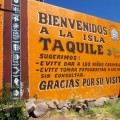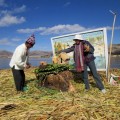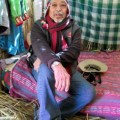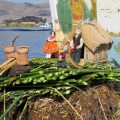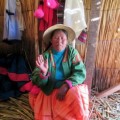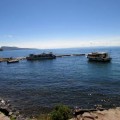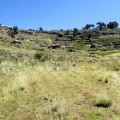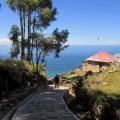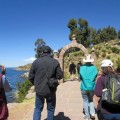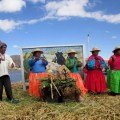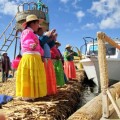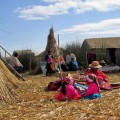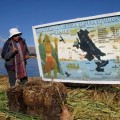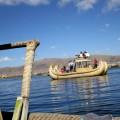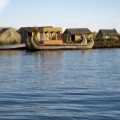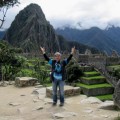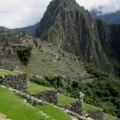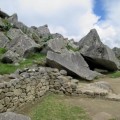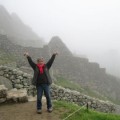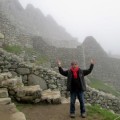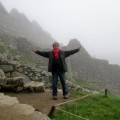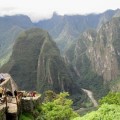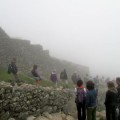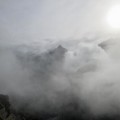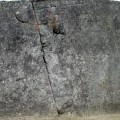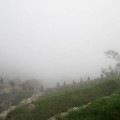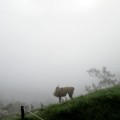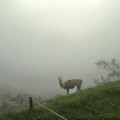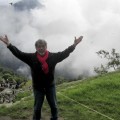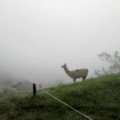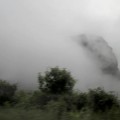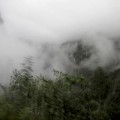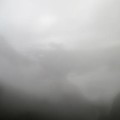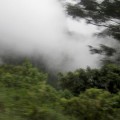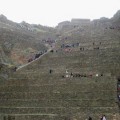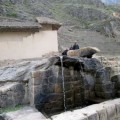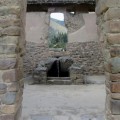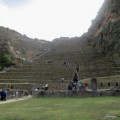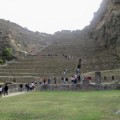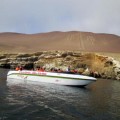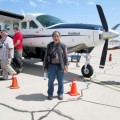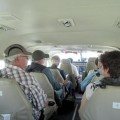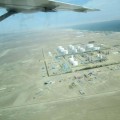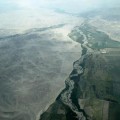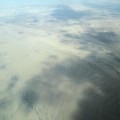Month: May 2014
Gallery – Photos from Lake Titicaca
At 12500 feet above sea level, Lake Titicaca is the highest navigable lake in the world. The tour started at a “floating island” of totora reeds — Islas Ios Uros. The guide, assisted by a man from the village, gave a lecture on the history and lifestyle of the people. It was all cut and dry talk, but sometimes humorous, a backgrounder on Lake Titicaca and the Aynmara and Quechua people who have lived there for hundreds of years. The women were called to sing a couple of songs in their ancient language. Then, the guide announced that they were going to sing a translation. They broke into “My bonnie lies over the ocean.” Later, as the tour group sailed down on one of the reed boats, the women sang, ” Row, row, row your boat.” Some of us in the group laughed. Next stop on the lake tour was Taquile Island. The boat anchored and we all shuffled up the steep incline to the top where we had our lunch of grilled trout and potato chips. I decided to jump in the water as a friend suggested. I left the group, walked down to the water, took off my clothes and plunged in. The water was frigid. A man took photos of me. I saw the photos later before my camera got lost or stolen. One photo showed me in the water with the sunlight shimmering around me. The next day, on a trip to Sillustani, my guide George
Washington said that swimming in the water of Lake Titicaca is a ritual of cleansing and healing. In Mount Banahaw, the holy mountain south of Manila in the Philippines, the pilgrim stands under the waterfall and bathes in the river at the bottom of the mountain in the act of purification before s/he goes up to the different stations to light a candle in each
spot. The symbolic descent and washing are part of the rituals all over the world.
Gallery – Photos from Machu Picchu
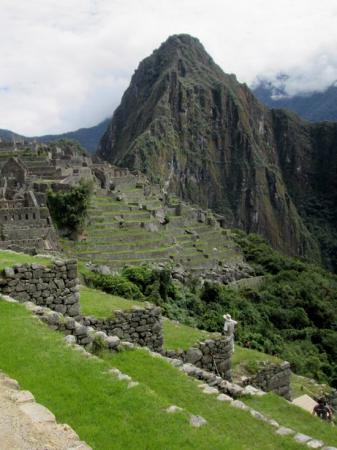
The Dragon. The guide emphasized that this was Huayna Picchu, the mountain that is in the
popular imagination when there’s talk about Machu Picchu. Machu Picchu is across from the temple
ruins and is not particularly attractive. A special permit (and fee) is required to climb Huayna Picchu.
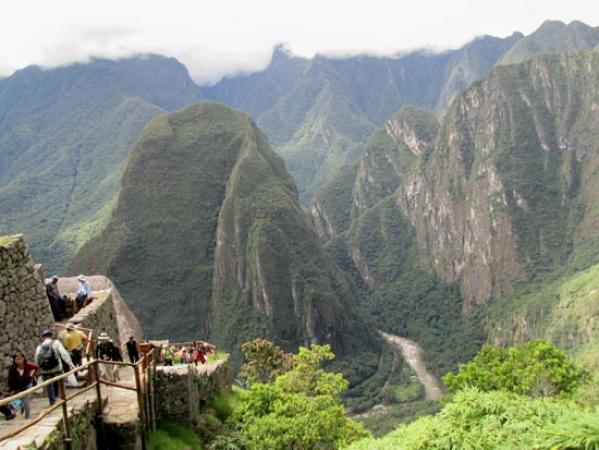
The Tiger. To me, this was the mountain that represented the Tiger energy. If you followed its tail, you will see that it reaches down to the river below like the Dragon.
Gallery – Photos from Ollantaytambo
I arrived at Ollantaytambo in the afternoon of a Saturday after a tour of the Sacred Valley and before I was taken to the hotel. I could have climbed up to the summit of this fortress, like everybody did, but it did not make much sense to be spending all that energy to see the town below or the constructions at the top. There are many and more phenomenal such constructions — Bolivia, Ecuador, Mexico, Egypt. As far as I am concerned, the jury is still out regarding the issue of who built them and with what technology. I sat on a boulder alone, meditated and, as I usually do, “tested” the energy frequency of the place. It did not have a pleasant vibration. The qi felt “sticky” and impure. Although I did not know it at the time, I presumed there was a bloody engagement here. The air carried the memory of a long bloody struggle from the past. I learned later that there was an extended battle that ended in a massacre of the natives by the soldiers of Hernando Pizarro in the 16th century.
These are the remaining photos of the place from my Canon Powershot A-2500. The others were in the Canon G12 Powershot that was lost in a Lima hotel. I did not have the time to walk downtown. When we passed it, i saw the old houses and the irrigation system. I would like to see the place next time around. Perhaps stay for a day or two. As well, I would like to return to the Sacred Valley. There were several places there that fascinated me … basically small towns and villages that seemed to promise a good energy. I stayed at the Sonesta Hotel, a 300-year old former convent that looked like a Spanish or Mexican hacienda — 2-story dormitories, red brick roofs, flower gardens, a chapel — bordered on 3 sides by green mountains. Because of the tight schedule, there wasn’t really much time to saunter — Saint Terre?- – anywhere.
Gallery – Photos from Paracas and Ballestas
After a tour of Lima, I took a 4 – hour bus ride to Paracas, a desert town on the shores of the Pacific. I was picked up at the bus station and taken to the airport for a plane ride over the Nazca Lines. If you suffer from motion sickness, especially, avoid eating a heavy breakfast because the plane maneuvers you will go through will make you quite nauseous.
Sadly, the photos of the Nazca Lines — huge etchings in the pampas/desert — were in the lost (or stolen) G12 Powershot camera. While looking at them from the air, the drawings of a hummingbird, monkey, condor and others made me wonder who made them and why. I imagined this solitary artist, alone in the desert, who wanted to make himself famous. He decided the best way to do it would be to devise a way to create these figures so large that posterity would grant him recognition and acclaim. Well, humanity is still puzzling over how it was done. The problem is that while his work remains he forgot to sign it and, the unkindest cut of all, it is credited to extraterrestrials by certain groups. The only photo I have of these lines is of the “candelabra” on a cliff by the edge of the sea in the Ballestas islands.
After the plane ride, my transport took me to Double Tree Hotel. It turned out that the manager is from the Philippines. We come from the same linguistic group: he came from Pampanga and I came from the next town north. We had an hour of conversation and pisco sour drinks . When I mentioned that I have seen cherimoya in Lima, he called the waiter and put in an order for a Cherimoya Napoleon. That was my dessert for dinner. The next day I took the tour of Islas Ballestas — an ecological sanctuary in the Pacific. Paracas and Ballestas gave me a chance to acclimatize to the demanding walks in the Sacred Valley and Machu Picchu.
May 2014 – Peru
May 16, 2014
Dear Friends:
Got back from Peru last Saturday May 10. From Newark Airport I took the bus home to Easton, unloaded my luggage, and drove to Middletown, DE for the Arts Weekend at St Andrews School. Granddaughter Isabel, 16, is a junior there now. She had a few oil paintings in the art exhibit at the gallery, a stint in the chorus in Purcell’s Dido and Aeneas (one rare production by a high school anywhere in the world, I believe), and a small role in the drama “A Guest in the House.” She also plays trumpet for the school orchestra but I missed their performance on Friday night. Her sister Ava, 13, is a nationally ranked epee’ist and won a gold medal in team fencing in the nationals in Memphis recently. She travels with Al, her dad, to different competitions in other states. I try to take the time to attend her local tournaments, too. Sometimes, it could get frantic, scheduling different activities in different places, putting my own writing on the back burner, but I do not like to miss being a part of their young lives. So here’s a blog that is late.
Peru was an incredibly powerful and varied experience. Everything, except Lima and Cuzco, was gratifying and transformative. There are exceptions, but I don’t very much like visiting churches and catacombs. I did that in Rome 4 years ago. Like the churches in Lima and Cusco, the basilica of San Clementi was built on the ruins of an old pagan temple. Our group went two levels down where a cavern held the remnants of an ancient temple dedicated to a prophet. There are different versions of his life. It is said he was born of a virgin on Christmas Day, attended by 3 shepherds, preached love and compassion, had 12 disciples, was called the Light of the World. Before his death, he had a last supper at which bread and wine were consecrated as symbolic of his flesh and blood. He died and was resurrected on the third day. He was born 500 years before Jesus. His name was Mithra.
The truly funny scene in the church tour in Cusco was seeing the painting of the Last Supper with a grilled cuy/guinea pig on the table. Was that perhaps a bottle or a glass of pisco sour waiting to be finished? I did not eat a cuy. A friend who has taught in the Andes recommended it. I had soups – quinoa, asparagus, potato, squash – and meat (alpaca, beef, lamb) and trout instead. I avoided alcohol, except for pisco sour, and coffee. I had the apparently obligatory mate de coca regularly that simultaneously relaxes and energizes.
When a Filipino friend, a writer now living in the Philippines, received my photos of Peru, he said that traveling to Machu Picchu was something he had dreamed of since he was a child. I can understand it because as a young kid growing up in a small town, I had never left the island, was awed by big cities and distant places. I was in a real sense from the boondocks – from the Filipino word “bundok” or mountain – now a disparaging reference to a hick in the US. Along with Egypt, this Peruvian destination was likewise on my bucket list since I cannot remember when. Although I traveled to different provinces in the Philippines to attend student writers’ and leadership conferences, it wasn’t until I was 30 that I traveled outside the country. The last 30 years I have seen Spain, England, Scotland, France, Egypt, Cyprus, Czech Republic, Iceland, Brazil, Argentina, Laos, Slovenia, Croatia, Indonesia, Turkey, Greece, Thailand, Cambodia, Italy, Taiwan, China (many times), Mexico. Quite a few of these countries have sacred places, with an ancient tradition of spirituality and energetic power. I visit them not just to see but to “connect” to the power vortices through my Daoist practices.
Carrying a Philippine passport, like I do, it is more difficult to get a visa to some European countries, especially those on the Schengen list, because they require many documents – income tax returns for the last 3 years; bank account the last 3 months; travel insurance; itinerary with the names and addresses of the hotels and the travel guides; medical insurance; credit cards; and a personal interview. Sometimes I cannot help the feeling that their consulates and embassies are unnecessarily stringent in granting visas especially to Filipinos.
Now, at 73, egged on by that old wisdom — If not now, when? — I decided it was time to do it. So I dipped into my IRA, something I often do now to fund my travels. I did some training in the gym to develop my stamina, breathing and my legs. A student who saw my photos of Peru confessed that she was envious. I told her that the way I have been spending, I’ll probably die broke.
Since Machu Picchu was now the focus of my gypsy blood, I visited two days in a row: with a tour guide late in the morning on the first day/Sunday just when I had just arrived by train in Aguas Calientes from Ollantaytambo and the Sacred Valley and alone by myself early at dawn on the second day/Monday. The temple complex was crowded on Sunday because, according to the guide, the local people were allowed to come in for free. Our small group walked the whole domain and I tagged along. I took pictures. There was no time to meditate. When I asked the guide about the shamans, I felt he dismissed my question by saying they were in the forest. On Monday, I woke up early at dawn, skipped breakfast and took a bus to a Machu Picchu covered with mist. I chose a feng-shui/geomancy spot in the triangulation of the Dragon and the Tiger that I thought was one of the vortices of the place and stayed there for my routines. I did my Daoist practice – Xing Shen Zhuang Fa, DragonWell Qigong, bits of Taiji.
From a distance, a white llama was taking glances at me while she was nibbling at the grass. Before I knew it, the llama was just a few feet away and was standing on the same flat ground. I chatted with her, got her permission to take a few photos, and then said goodbye because people were beginning to gather around us. I moved to another spot about 50 feet way. I did my practice there, too. I lighted an incense stick and stuck it in the ground. The same llama came up to me again. When tourists began crowding to take her picture, I told her to go.
The last important stop was LakeTiticaca, the highest navigable lake in the world at 12, 500 feet. I was picked up at the Juliaca Airport by Sylvia, a native travel guide. In the course of our conversation, part Spanish, part English, she asked me where I was from. I asked her to guess. She said, China, Japan, Peru. Peru? She said I have forgotten my Spanish. I said she is 40 years old, a shaman who studied with her grandmother. How did you know? she asked. Are you a shaman? I said, Perhaps you could teach me something if you have the time. She was supposed to be my guide for the 2 days I was going to vein Puno so it could be scheduled. But that night she called and said she was taken off the list and somebody else took over. Sylvia, it turned out, has been teaching shamanism in different countries – US and Australia and France. She gave me her schedule of seminars in the US: she wanted for us to work together. Another woman took over the tour of Lake Titicaca.
George Washington (his real name) was the guide on my last day in Puno. He explained that the company he and Sylvia worked for was owned by a Señor Jorge Luis Delgado. I remarked that he wrote a book on “Andean Reawakening: An Inca Guide to Mystical Peru,” a memoir of his education as a shaman. I received a copy of the book from a friend who had gone to Peru in July of last year. George took me to a graveyard/necropolis in Sillustani– a “Temple of the Dead” he said — on the way to the airport and explained a few things — the 3 Inca Rules (living a life of munay/love, llancay/service and yachay/wisdom) that define a meaningful life, the levels of consciousness the initiate achieves as he drinks the decoction from a 7 sided cactus as s/he is led by a chacaruna (a shaman who guided him in this journey he said), and the etchings on the floor of the square, an elaborate circle representing the Chacana/Peruvian cross. I had a background in the subject, of course, because I had read Senor Delgado but George also mentioned pi and its application to the Peruvian cross. I had a background in it, too, because I had studied books about Egypt, the measurement of the temples and pyramids and the concept of the Divine Proportion.
Just the same, I was struck by his knowledge. He talked about the “apacheta” (meaning “take it away” or “let it go”) – stones that carried heavy emotions or energy to be discharged to Mother Earth in the Andean ritual of exorcism and healing. He taught me how to say, “tupananchiscama, the Inca way of saying “till we meet again” in whatever dimension, time or world. He explained the alignment of the circle at Sillustani, the observance of the Summer Solstice and Winter Solstice on December 21 and June 21 respectively (opposite to the West) and the role of the Southern Cross (other countries in the West follow the North Star/Polaris). I wish I had more time to spend with him since he was quite knowledgeable for his age (25). The other guides were not as informative about the esoteric and mystical aspects of Peru, so this was something different.
George and I moved around the circle in Sillustani as we talked and did postures. He explained to me the imagery of the 3 Worlds and their representations — Snake for the underground and the past; Puma for the earth and the present; and the Condor for the spiritual and the future.
It was the end of my journey and I was going back to Lima for my return flight to the US, so I could not do much about it. I spent the last 2 days in the capital, took one last tour of an ancient temple – called Roma de Andes — outside Lima and waited for my flight. I had packed everything in the hotel, put my luggage in storage, and waited in the lobby. It occurred to me that I did not see my 2 cameras. I found one in the pocket of my vest, but the Canon G12 Powershot that I often used was gone. I tried to recall where I had last seen it. I knew I did not leave it in the van that took me back to the note. I knew I did not leave it in the room where I had just checked out.
I informed the hotel staff. They called the tour company, they searched in the room. Nothing. I looked inside my 2 pieces of luggage and my backpack. Nothing. On my way to the airport, I remembered I had wrapped it in a white plastic bag and tucked it inside the luggage. So I had one last hope that it was still there and I had just missed it. To make a long story short, I emptied everything on the floor when I got home and I did not find it. So most of my photos are lost. Perhaps the hotel won’t find my camera either. My suspicion now is that somebody stole it while it was in storage in the hotel. That was the only time that the luggage with the camera in it was out of my sight.
Here are the photos taken with my smaller camera.
I am sad and a bit angry with myself for not holding on to the camera. But how would I have foreseen that somebody in the hotel staff — the only possible culprit in this case — would do something dishonest? It is one of the hazards of travel. Important items are sometimes lost … or stolen. Sometimes it is in the airport when the luggage is with the baggage people or in the course of a tour when one leaves stuff in the bus or van.
I told the hotel staff that I don’t need the camera, but I do want the memory card back because it contains most of my photos. I left my card containing my contact info with them. But I am skeptical about hearing from them again. A friend who also travels a lot advised me to put a lock on my luggage. I guess I’ll do that next time. I’ve thought about the loss of the camera and the memory card. They were a record of my journey but they were not the journey: the pilgrimage I had taken is etched in my mind, spirit and body. That is something I am grateful for and could reconstruct and relive in my meditation. Perhaps it’s just as well that the photos were lost. They gave me an opportunity to let go.
What are the important lessons and valuable knowledge from my pilgrimage to Peru? Well, I was curious about where the gold the Spanish conquistador plundered eventually went. Have there been any attempts to return it? I also wondered if Spain ever apologized for the horrors that were inflicted on the natives. In restrospect, I should have chosen a tour that was led by a shaman or that allowed access to a shaman. I would have wanted to be part of an ancient Inca ritual. There are such tours advertised in New Age magazines. At the same time I really wanted just to be alone and receive whatever was coming to me at random in a kind of serendipity: To see the country on my own, do my own practices and wait for magic to happen. I was willing to be guided to some extent like an ordinary tourist especially in Lima and Cusco, cities that did not have much attraction to me. As far as the monumental walls are concerned, they were incredible, but I was not consumed by the huge structures that have intrigued and fascinated people inspiring speculations about extra-terrestial beings. After all, I had seen the same structural marvels in Mexico and Egypt. What I was looking – or prepared myself — for instead were mystical experiences in Machu Picchu and Lake Titicaca through the ancient methods of alchemy, Taiji and qigong. Peru was another victim of Spanish colonization but it retained much of its ancient architecture and indigenous beliefs and its structures offer places of contemplation and ritual. I did find – or was gifted with — quite a few treasures during my 2 days in Machu Picchu.
Every journey one takes to a country like Peru offers, not just a travel, but an initiation and ritual. The rare access to the energy and traditions of the place, the iconography of the people and their history, the magic of transformation and alchemy, open gates to an ancient mystery that is still – and perhaps always – available to those who believe and are ready for it.
Blessings, always, and with love!
Rene
www. renenavarro. org
PS: (1) After writing the blog, I discovered when I received my Visa statement that somebody charged $156 for a ticket for a flight in Lima from my credit card a few days after I left Peru for the US. It was probably an inside job too. (2) If you are interested in a basic meditation in sacred places, please goto my essay “Opening the Body to Nature” Vol. 3 #4 in the August-September 2013 issue of Yang-Sheng Magazine on the internet.
